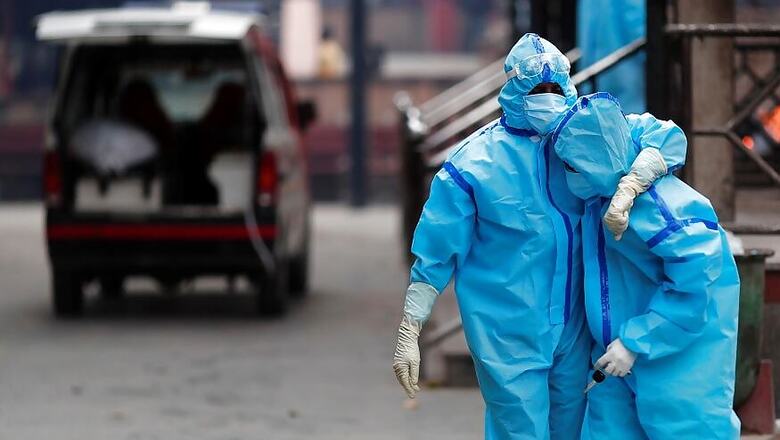
views
Global consensus advises decisions during the time of coronavirus pandemic must be based on latest scientific evidence. This is a tall order even for the most sophisticated administrations, given the amplitude of Covid-19 related research being outputted. Most governments are struggling to stay ahead of the pandemic, juggling limited resources, fighting recessions, struggling to keep public morale up, and public opinion positive.
Prime Minister Narendra Modi, through a strong intuition and understanding, guided the nation very effectively from the very beginning. He exhorted us to wear masks, even before WHO released an advisory on it, requesting us to stay at home, while he relentlessly worked to keep our health and hearths in order. Necessity of lockdowns and distance measures are now being affirmed by research at highest levels. While the countries count the lives lost due to delayed decisions on lockdowns, India very fortunately counts the lives saved due to imposition of timely lockdown, which are in lakhs.
We need to move forward in unison with him, making use of latest evidence on the pandemic offered by science.
This paper attempts to present latest in research on mode of transmission, clinical course, and vulnerabilities of SARS-COV-2 virus and the disease caused by it -- Covid-19 -- from hundreds of reliable scientific resources. It also directs attention of policymakers to prescriptions of multilateral agencies like WHO, WEF, ILO etc. setting guidelines on medico-socio-economic interventions and their expected outcomes. Hopefully, its objective findings shall be helpful for policymakers, and quell some curiosity of public as well.
SITREP
How is India doing?
On June 6, 2020, India reported 246,530 coronavirus cases, 6,946 deaths and 118,592 recoveries.
Best source for all information is the Johns Hopkins Dashboard for pandemic monitoring.
Also, the latest sitrep number 138 from WHO published on June 6 indicates cases in Asia are still a much lower fraction of total cases, and the Americas and the Europe are leading the globe in pandemic spread, cases and fatalities.
Unfortunately, the trajectory of the pandemic is on a sharp upturn in India after lockdown has been relaxed.
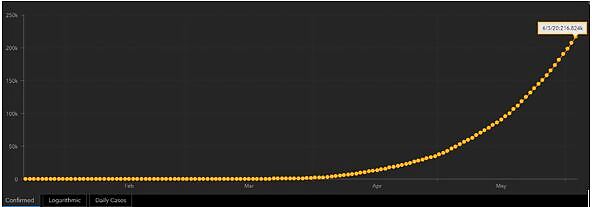
Total confirmed cases in India, 3 June 2020, Source: JHU
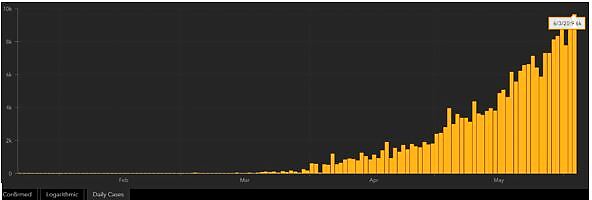
Daily confirmed cases in India, 3 June 2020, Source: JHU
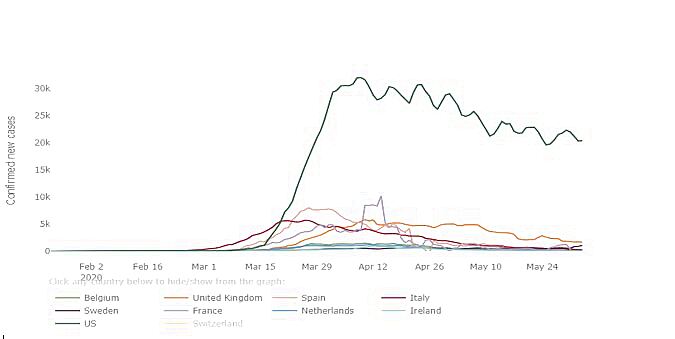
Cases in top 10 affected countries in the world on 3 June, Source: JHU
Most of the top 10 countries, carrying highest disease load in the world are showing receding trends, and their incidence curve is cresting, except Sweden where no lockdown was imposed ever.
India now is in competition with Sweden and Brazil, the countries who have exhibited very lax discipline in imposing lockdowns and social distancing. Their trajectories are on expected lines, but ours is unexpected despite imposing one of the most stringent lockdowns in the world.
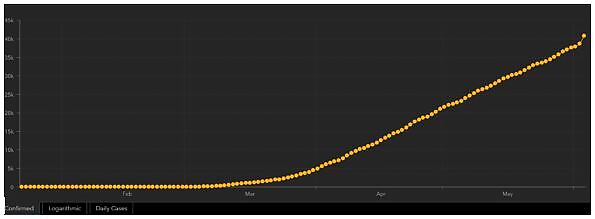
Sweden, as on 3 June, Source: JHU
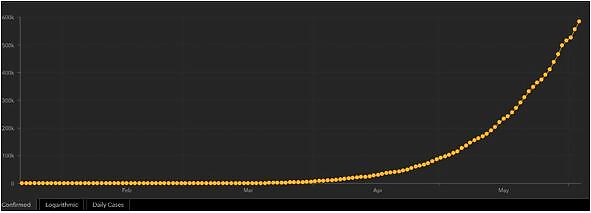
Brazil, as on 3 June, Source: JHU
In its latest press conference, WHO advised governments to access latest in science on Covid-19 and SARS-Cov-2 and base their policies and strategies on such information. The global overall suppression strategy remains testing, masks, social distancing, selective lockdowns, and hygiene.
How well is India coping mentally?
Sentiment analysis of Twitter in urban areas shows that the feelings of urban India are still neutral to positive on the issue. A rural survey of migrant laborers also indicate that approval of a stringent step as lockdown was universal, and reason for migration was non-availability of work at urban centers.
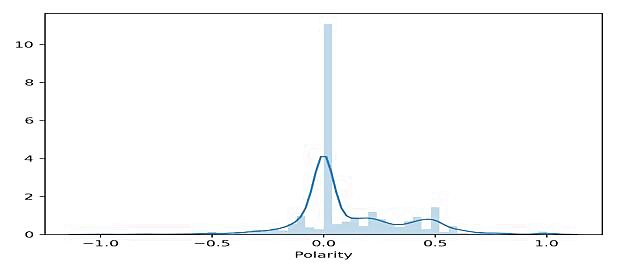
Twitter sentiment analysis #Lockdown, polarity, 4 June 2020
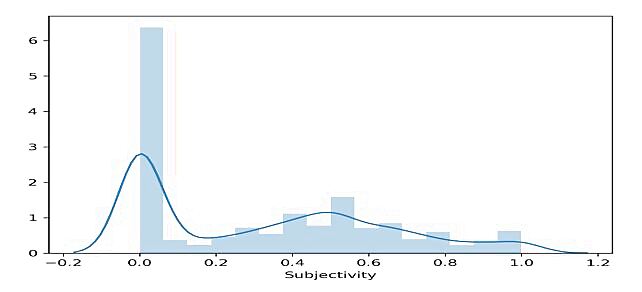
Twitter sentiment analysis #Lockdown, subjectivity, 4 June 2020
People are actually expressing positive opinion on the subject of lockdown, as in lower figure; and the overall sentiment is neutral to positive as seen in upper figure.
ON MEDICAL ADVANCES
The primary objective of the Covid-19 global response is to slow and stop transmission, find, isolate, and test every suspect case, and provide timely appropriate care of patients with Covid-19.
As per latest WHO publication on clinical management of Covid-19, known risk factors for rapid deterioration, severe disease, and/or increased mortality are: older age (> 60 years) and Non Communicable Diseases such as cardiovascular disease, diabetes mellitus, chronic lung disease, cancer and cerebrovascular disease.
SIGNS AND SYMPTOMS
Presenting signs and symptoms of Covid-19 vary.
Most persons experience fever (83–99%), cough (59–82%), fatigue (44–70%), anorexia (40–84%), shortness of breath (31–40%), myalgias (11–35%). Other non-specific symptoms, such as sore throat, nasal congestion, headache, diarrhea, nausea, and vomiting, have also been reported. Loss of smell (anosmia) or loss of taste (ageusia) preceding the onset of respiratory symptoms has also been reported.
Older people and immunosuppressed patients in particular may present with atypical symptoms such as fatigue, reduced alertness, reduced mobility, diarrhea, loss of appetite, delirium, and absence of fever.
Symptoms such as dyspnea, fever, gastrointestinal (GI) symptoms or fatigue due to physiologic adaptations in pregnant women, adverse pregnancy events, or other diseases such as malaria, may overlap with symptoms of Covid-19.
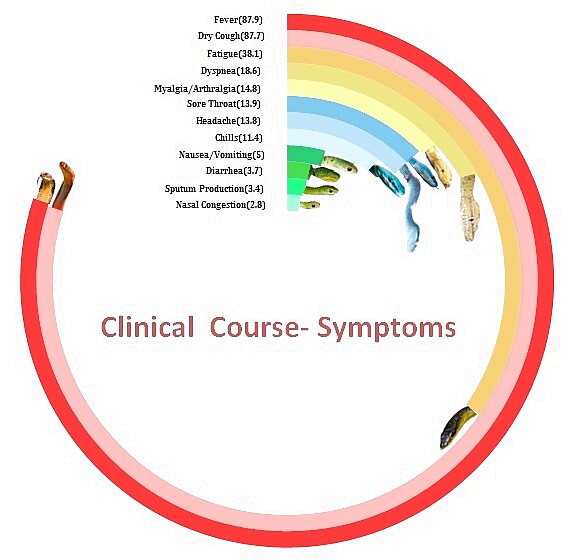
Symptoms of Covid-19, Source: Author (Dyspnea = Breathlessness, Myalgia = Muscle pain, Arthralgia = Joint pain)
Children might not have reported fever or cough as frequently as adults.
Covid-19 patients not displaying symptoms are more likely to be younger, and female as per a small peer-reviewed study in Wuhan.
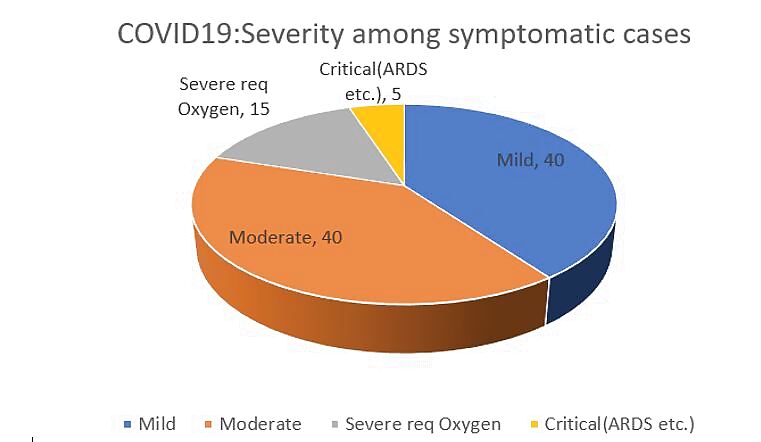
Severity of disease among symptomatic cases, Source: Author, Data: WHO
VACCINE
Efforts to get a vaccine are moving at an unprecedented scale, and there are hundreds of candidates under trial.
Oxford vaccine is likely to hit markets in October, but we may expect that full availability will still be after this year is over. And vaccinating the entire population on the globe will be logistically long drawn and may take a couple of more years.
Also, more efficient vaccines shall keep entering the domain. The outlook on this front is very optimistic.
On our level, we have to support any such effort in our jurisdiction, smoothen the approvals and licensing requirements and plug gaps in logistics in advance like cold chain infrastructure etc.
DRUGS
On the medicine front, two drugs have passed the clinical trials- Ramdesivir, an antiviral, and Tocilizumab- an anti-inflammatory drug. The former is proven to prevent progression of disease to serious stage if administered early in the course of the disease. The latter prevents deaths in critical patients by modulating fatal inflammatory responses. These do not work 100 percent of the times in all the patients, so we need more drug discovery.
National Principal Scientific Advisor KV Raghavan announced launch of drug discovery hackathon where high-end computational drug discovery tools are now available openly to all, and everyone from medical and pharmacy students to highly experienced scientists can work on this platform for drug discovery. It is like crowd sourcing of innovation, and since we have immense scientific talent in our population pool, we may find success soon. Do carry this information to those who can use this.
MECHANISM OF ACTION AND DISEASE PROGRESSION
On the treatment front, we have started to understand the mechanisms as to how this virus causes the syndrome we see in symptomatic patients. The primary pathway of entry is lungs, but the primary target is lining of blood vessels, be it capillaries of lungs or of periphery.
Add to it the hematological injury caused by body’s own immune response, and the results are devastating in those who progress to serious form of disease.
This helps to explain why ventilators are not helping more patients. A study of 5,700 patients hospitalised with Covid-19 in New York City found that while just 12% needed a ventilator to help them breathe, 88% of those patients died.
Medical fraternity is working hard at designing specific cocktails of drugs keeping in mind latest research.
But the management of symptomatic Covid-19 is still largely supportive, and the major toll is among elderly and those having comorbidities.
Death rate in India is much lower than other countries, and we still have to find out reasons for this very lucky fact.
So, we cannot let up our vigil and precautionary approach till we succeed in getting a vaccine or cure.
A lot of success depends on discipline shown by citizens, which unfortunately has been missing so far, unless enforced, putting a lot of lives, especially of elderly, at grave risk. We must control the spread.
SPREAD
Studies say 44 to 88 percent of cases of Covid-19 are asymptomatic- meaning out of a hundred people having virus in their bodies, around half on an average will not have any symptoms like fever or cough.
But these people can spread the virus around.
An asymptomatic person spreads for 9 days compared to symptomatics who keep spreading for 19 days.
Limited published and pre-published information provides estimates on viral shedding of up to 9 days for mild patients and up to 20 days in hospitalized patients. Additionally, there are reports that patients can remain consistently polymerase chain reaction (PCR) positive for many weeks, or even test PCR positive after days/weeks of a negative test. (WHO)
So, when we allow people to go about their routines how do we ensure such people do not spread the virus and jeopardize lives of more susceptible persons?
The answer is we need data on positivity and prevalence among communities- and that data can only be obtained through testing.
So far, the data from such tests across globe have shown Covid-19 is more widespread and thus less lethal than previously thought.
LOCKDOWNS: RATIONALE
This disease is more of a public health phenomenon than therapeutic. Lockdowns help. Period.
That said, let us understand the science and logic behind effective containment strategies like lock-down and social distancing.
Evidence suggests that restricting gatherings where superspreading is likely to occur will have a major impact on transmission, and that other restrictions—on outdoor activity, for example—going to work, market etc.- might be eased, of course with distance measures in effect.
Most of the discussion around the spread of SARS-CoV-2 has concentrated on the average number of new infections caused by each patient. Without social distancing, this reproduction number (R) is about three. But in real life, some people infect many others and others do not spread the disease at all. In fact, the latter is the norm. The consistent pattern is that the most common number is zero. Most people do not transmit.
Dispersion factor of Covid informs that most chains of infection die out by themselves.
This is the biggest evidence in favor of lockdown, which has likely prevented lakhs of deaths in India by preventing such super-spreader events.
Japan, which was hit early but has kept the epidemic under control, has built its Covid-19 strategy explicitly around avoiding clusters.
One study from Columbia University says if the United States had begun imposing social distancing measures one week earlier than it did in March, about 36,000 fewer people would have died in the coronavirus outbreak.
And if the country had begun locking down cities and limiting social contact on March 1, the vast majority of the US’s deaths — about 83 percent — would have been avoided.
Under that scenario, about 54,000 fewer people would have died by early May.
Similar estimates have been made for India, but fortunately they have been about lives actually saved. That is something to chew on for critics of lockdown.
FATALITY RATES
India has some of the lowest case fatality rates due to Covid-19 in the world.
If we understand the physiological basis for less number of Indian deaths due to Covid-19 as it would help us to tailor drugs for those who have active disease, take decisions on opening up and also help the world in using this unique Indian advantage.
My understanding is it might be merely demographic, as median age of Indians is 29 compared to 38 for Americans, Europeans are also primarily older populations.
If that is the case, we do not have any actual benefit if adjusted for age, and our policy would be informed merely by watching what these nations are doing.
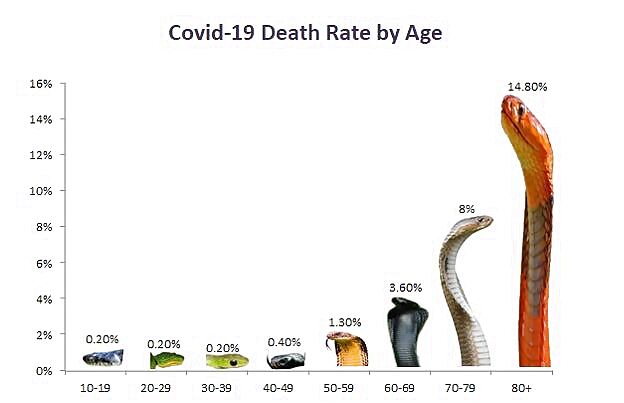
Age wise case fatality rates of COVID-19, Source: Author, Data Source: CDC, China
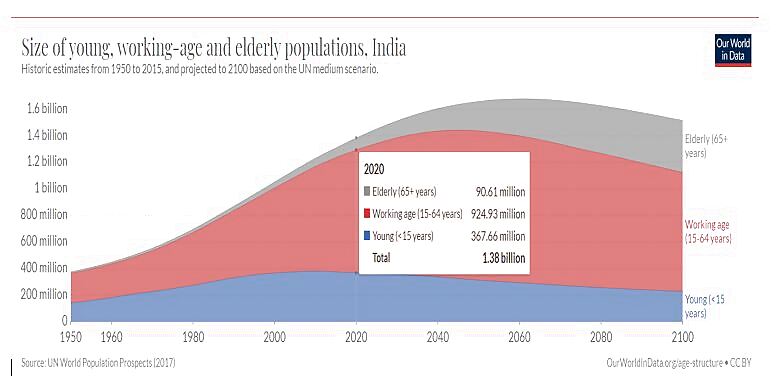
Age wise population distribution, India 2020, Source: Our World in Data
Country-Wise Fatality Rates
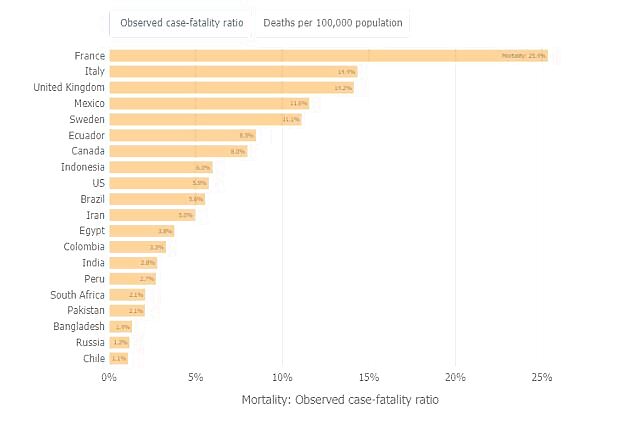
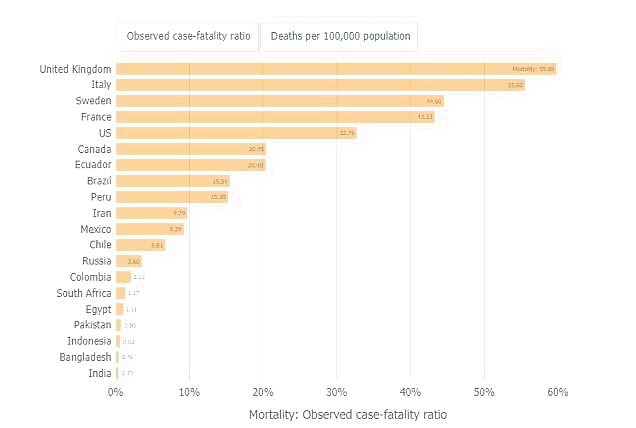
COVID-19 Case fatality rate and deaths per million are some of the lowest in the world. Source: JHU, 3 June
Cases and mortality by country
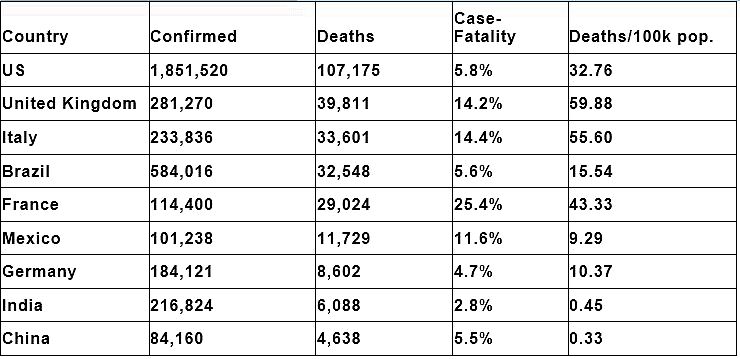
Source: JHU, 3 June 2020
ON TESTING
Serological testing (Antibody based) is the gateway to an open economy, as is diagnostic testing (RT-PCR) for successful suppression.

COVID-19 diagnostic test positivity rates
Data Sources: international testing data from Our World in Data, cases data from JHU CSSE, and world population from The World Bank
According to Johns Hopkins University, looking at the positivity rate (i.e., out of all tests conducted, how many came back positive for COVID-19) is the most reliable way to determine if a government is testing enough. A high rate of positive tests indicates a government is only testing the sickest patients who seek out medical attention and is not casting a wide enough net. The WHO has issued guidance stating that governments should see positivity rates below 5% for at least 14 days before relaxing social distancing measures.
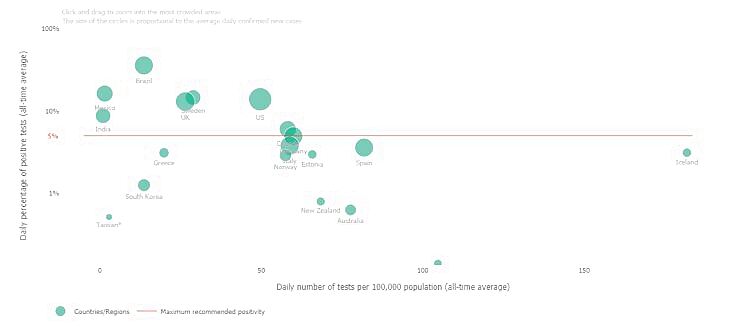
COVID-19 diagnostic test positivity rates and total tests, Source: JHU
There is no single formula for how much testing is adequate. US is performing a large number of tests, almost 50 times than India, but is unable to control the spread of the pandemic successfully so far. Therefore, we must tailor testing depending on size of epidemic, region wise, to keep positivity rates below 5%.
By this criterion, India is not testing enough.
If we look at tests performed per thousand people, we lag behind both types of the countries- having controlled and still struggling.

Confirmatory tests performed per 1000 people, Source: Our World in Data
On the positive front, ICMR has approved sero-surveillance through IgG ELISA and CLIA , antibody tests, to understand the proportion of population exposed to infection including asymptomatic individuals. Depending upon the level of seroprevalence of infection, matching public health interventions can be implemented for prevention and control of the disease.
ICMR also recommends use for survey in high risk or vulnerable populations (health care workers, frontline workers, immunocompromised individuals, individuals in containment zones etc.) to know who has been infected in the past and has now recovered.
Such tests help to keep workspaces safe, and also inform if someone was once infected but then recovered, freeing up her resource for work.
These are also the potential donors of blood for plasma therapy.
There is an alternative to testing for controlling the pandemic - Method of Track and Trace.
Analysis by the ILO has found effective track and trace measures can significantly soften the economic harm of COVID-19 restrictions – reducing lost working hours by as much as 50%.
This is because such measures can give employees and employers the confidence to begin to return to work. The ILO warns that a weaker intensity of tracking and tracing will mean nations lose 7% more hours to lockdown disruption than ones with higher intensity programs.
Japan is one example of a nation that has focused its approach to the virus in this way, concentrating on rapidly containing small outbreaks through tracing instead of mass testing. It has experienced a lower death rate than many other nations – although it’s unclear if other factors contributed to this too – and is now reopening its economy.
Japan’s other strategies are a universal use of masks, and avoidance of three C’s- Closed spaces, Crowding and Close contact. These are simple behavioral interventions with minimum costs but promise huge benefits in terms of containment of pandemic.
For more details, please visit source.
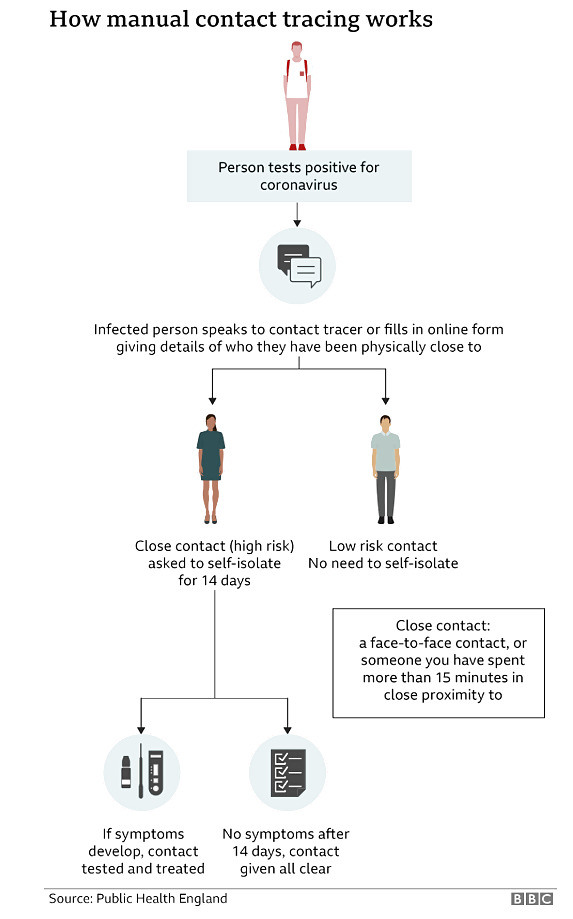
England's track and trace system is currently manual, though it is trialing an app. Image: Public Health England/BBC
ON SCHOOL REOPENING
In a study that is yet to be peer reviewed, children and adolescents were found to be 56% less likely to become infected by the virus that causes COVID-19 than over-20s when in contact with an infected person.
Clinical manifestations of COVID-19 are generally milder in children compared with adults. Relatively few cases of infants confirmed with COVID-19 have been reported; infants also experience mild illness. However, most recently, an acute presentation with a hyperinflammatory syndrome leading to multiorgan failure and shock has been described (31), now described as multisystem inflammatory syndrome temporally associated with COVID-19 in children and adolescents. (WHO)
Among 345 children with laboratory-confirmed COVID-19 and complete information about underlying conditions, 23% had an underlying condition, with chronic lung disease (including asthma), cardiovascular disease and immunosuppression most commonly reported.
Here are a few statistical concepts which might help decisions on opening schools and factories.
Value of a Statistical Life or VSL which is calculated using Disability Adjusted Life Years (DALY) and Quality Adjusted Life Years (QALY), basically indicating value of a disease-free healthy life.
Both contemporary science and contemporary philosophy agree that different lives have different values.
That value is calculated by discounting the wages earned and other productivity measures over the lifetime by a person had that person completed the expected life without getting any disease, disability or dying.
In the latest study on impact of COVID-19 infections, scientists modeled the infection and economic effects of social distancing, estimating a reduction of 17.6 lakh fatalities caused by COVID-19 due to the policy (social distancing, school closures and vaccination).
Their projected reduction in fatalities was composed of 11.3 lakh fewer deaths of COVID-19 patients receiving appropriate treatment (i.e., directed deaths) and 6.3 million fewer deaths of COVID-19 patients that are unable to receive ICU care because of pandemic related overcrowding (i.e., overflow deaths).
The Value of a Statistical Life was calculated per age group ranging from $1.5 million (11.5 crore Indian Rupees) for those over 80 years old to $16.1 million (122 crores Indian Rupees) for those between ages 20-29.
Younger lives are even more valuable.
We talk of mortality in percentages, but given India’s humungous population, very small percentages translate to big absolute numbers. Our willingness to take the risk of opening schools before a vaccine is made available depends on how cozy and alright are we with the news of thousands of children across nation suffering or dying of COVID-19 related causes.
We must be extremely cautious and aware of the risks inherent in opening schools before a vaccine is available, and children may not be able to maintain COVID-19 preventive measures at all times, which are so difficult for adults to consciously follow too.
Further, asymptomatic children acting as carriers of disease bringing it back to grandparents at home is a certain possibility given Indian family structure.
ON WORK
NELM presents proposed framework for workers of all categories when they start to work. (See fig below)
This is a broad guideline set by a doctor and may be used as a basic template to design our own appropriate response, where I recommend a national policy guideline for uniformity and compliance. Remember, any state can only hope to win the fight against COVID-19 only if its neighbors are also winning.
We can quantify occupational risks in terms of disease, disability, and death. In the current pandemic, those at higher risk must stay at home and save themselves from any exposure, those with low risks can go about working normally with proper use of masks, social distancing, and periodic risk assessment through Arogya Setu app and testing.
For example, workers in medical field including non-medical staff are at much higher risk (CDC says 11% of all infections in the US are among hospital workers), and their testing and prescribed leave/quarantine must accompany security of their payments especially in low ranking less remunerative daily wage jobs. The risks they are subjecting themselves to for such low payments increases our responsibility towards their welfare manifolds.
This stratification of risk to labor/workers in different occupations must accompany periodic serological testing at place of work to find active infections as well as those having been exposed to disease already and having antibodies in their blood who can be certified as free to roam and work, and can in fact be deployed at frontlines of fight like hospitals and quarantine centers.
I must add a caveat here that permanence of immunity against COVID-19 still does not have a scientific mandate as this virus is new. What we know is Measles virus gives permanent immunity, so you get just one series of injections, and flu gives temporary immunity, and you get poked every year.
Where on the spectrum does COVID-19 lie, we are not sure, but so far people having been cured and having the antibodies are established to be non-infective.
WHO in its 135th Sitrep gave detailed guidelines on reopening of work spaces, with strict emphasis on personal protection, social protection, distancing and hygiene.
ILO gives sectoral guidelines for safe work during COVID-19 pandemic.
ILO says “Testing and tracing of infections, as recommended by WHO, is strongly associated with lower labor market disruption”. ILO estimates suggest that testing and tracing can help to reduce working hour losses by as much as 50 per cent. The estimated average loss of hours for countries with the lowest intensity of testing and tracing is around 14 per cent, compared with 7 per cent for those with the highest intensity. This is an important factor to consider in the design of policy measures aimed at facilitating a safe return to work.
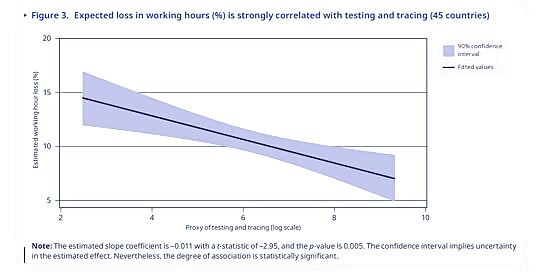
More testing and tracing- less loss of work. Source: ILO
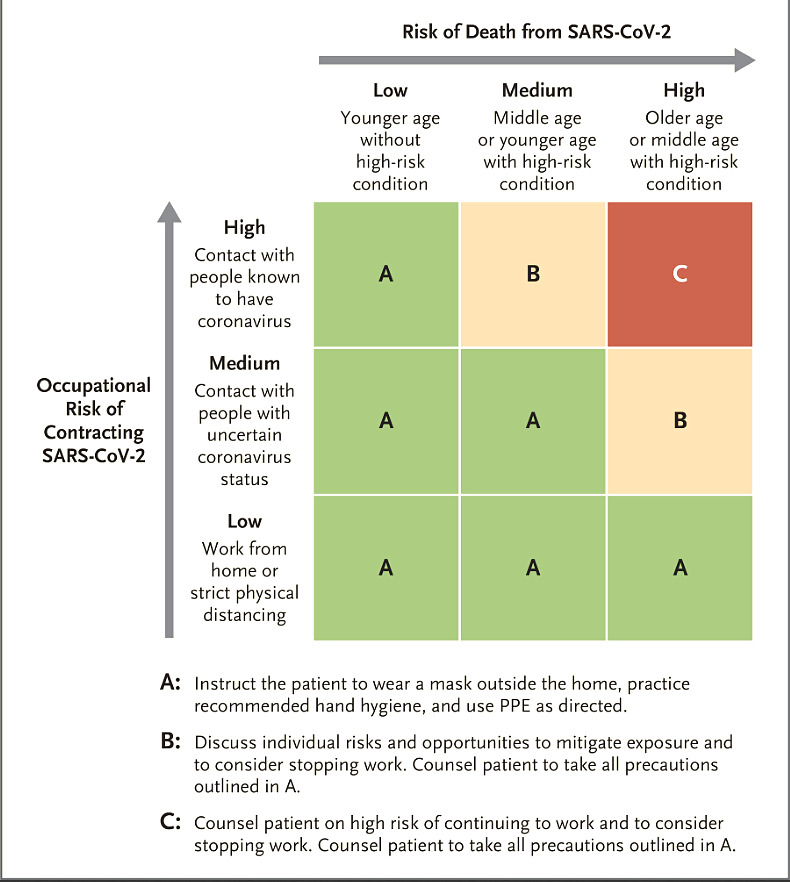
Proposed framework for occupational risk assessment for reopening work. Source: Marc R. Larochelle, MD, MPH, NEJM
ON MIGRATION
Measuring and understanding the problem is foremost requirement, besides provision of resources and political commitment if displaced people are to make tangible progress in re-establishing their lives.
A 2008 study conducted by author in 2008 in Nuapada district of Odisha, where 60% of workers migrated for 6 months in an year, analyzed the causes of migration. It was found that 88% of all movement was due to distress, and people migrated for better employment opportunities outside.
92% moved for assurance of regular work, only 31% were motivated by higher destination wages.
People reported getting regular employment at destination 87% of the times, whereas it was only 13% for the native place.
A very important finding was that if provided assured work in their villages, migrant laborers were willing to stay even if paid just 60% of destination wages.

Laborers in Nuapada migrated in food secure periods to get food security in lean periods, Source: Author
The recommendations for local economic rehabilitation of migrant workers revolved around remunerative agriculture, local employment opportunities through small scale industries and food security. A full exposition on the issue deserves a separate write-up.
In a new survey instituted by author on migrant laborers on the road, who were returning from Maharashtra to Bardhman, Howrah, Krishannagar and Nadia districts of West Bengal threw up following findings:
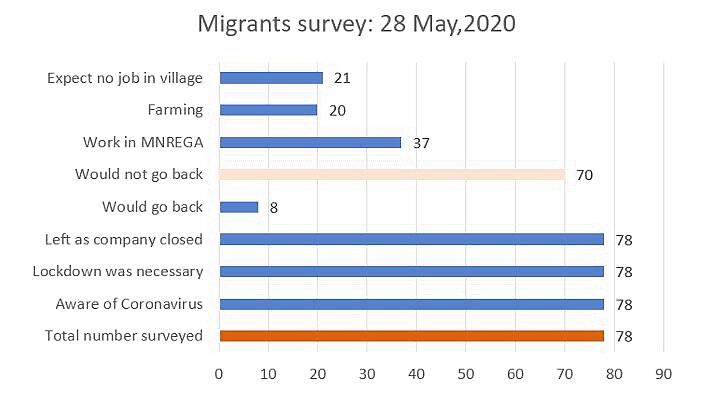
Result of survey on Migrant laborers on 28 May
All of them were returning from Maharashtra due to loss of job at the destination. Although 27% of them did not expect to find a job in their village, just 8 i.e.10% wanted to go back. Rest 90% wanted to stay back and earn their livelihood in the village itself. Surprisingly, all of them said lockdown was necessary, and it was because of their own compulsions, they are violating it.
LESSONS FROM CLOSER HOME: ODISHA MODEL OF COVID-19 CONTROL
Closer home if we look at individual state responses, Odisha has emerged as the leader in mounting a very successful response to the pandemic at the local level. Let us look at what the state is doing a bit closely. Many of the outcomes in Odisha are better than those in Kerala, and we can learn a thing or two about successful suppression strategy from the land of the Lord Jagannath.
Death Rate in Odisha due to COVID-19 is at 0.3% is lowest in the country (2.8%), as well as the world (5.8%). Cases pe million are just 33 in Odisha, for India these are 108. Odisha is testing 2861 per million, India, 2360 per million. Here there is one positive case per 86.75 tests, average over India is one case per 21.49 tests, meaning the spread has been contained more successfully here.
Odisha has arranged 5 lakhs quarantine beds across the state compared to 1.7 lakhs in India.
Odisha has 34 dedicated COVID Hospitals 34, Kerala has 27.
1.52 crore people are being served free meals in Odisha compared to Kerala, where the commensurate figure is 8.39 lakhs.
Here 48 lakh pensioners have been paid for 4 months; and another 82 lakhs poor households have received ration for 3 months.
One of our main strategies which has borne fruit is decentralized approach-Sarpanches have been delegated power of a District Magistrate under Disaster Management Act, making communication as well as containment successful with great speed at local Panchayat levels.
CONCLUSION
There is another full front where we need dexterity and acumen of very high level: propping up a struggling economy. Indian government is handling it to their best capacity. The evidence in this paper, based on COVID-19 science, presents a workable platform for gradual easing into business as usual on the work front. If people exercise high level of caution and discipline in their professional and social interactions, we can confidently open up like South Korea, New Zealand, and Japan.
Briefly, the economic package revealed by hon’ble Prime Minister, Mr. Narendra Modi, is designed for mitigating immediate problems, with an eye on long term redressal of downturn, as COVID-19 is likely to disturb the economy over a longer period than just its lifetime. Reforms in farming sector are powerful enough to both turn the tide on farm distress, and compulsory migration due to lack of rural jobs. Atmanirbhar Bharat is one plank that has the power to launch our nation on the trajectory of world dominance in manufacturing and services, while reducing our dependence on treacherous partners like China. More on this in my next article.
COVID-19, though highly contagious, carries low fatality risk for India given her relatively younger population. The job at hand is ensuring prevention of its spread among vulnerable populations i.e. older people and those with already existing medical conditions. We are already witnessing cracks in our medical preparation and must work on it on war-footing as we anticipate further increase in cases, and many more patients needing clinical care and hospitalizations in next few months. A second wave is expected in fall given worldwide trends.
Wearing masks, maintaining social distancing and hygiene shall allow us to open up safely, provided these are followed with military discipline. Cavalier attitude of just a few runs the risk of doing the entire country under.
So, let us keep repeating the panchmukhi (5-pronged) mantra till we banish this pandemic - Masks, social distancing, hygiene, testing and tracing. This is our only protection till vaccine or therapeutic treatment is made available. Another useful mantra given by our hon’ble PM is “Jaan Bhi Jahaan Bhi”. We shall save both lives and livelihood, but only by being careful and aware in our fight against COVID-19.













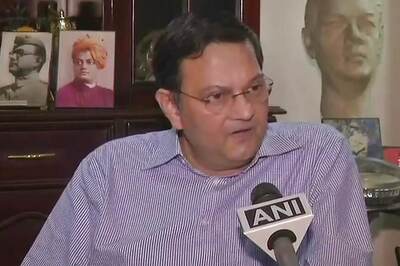






Comments
0 comment